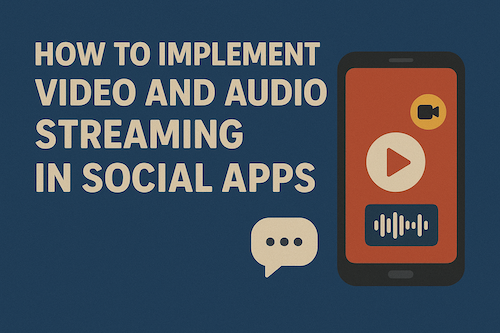In today’s digital era, social media platforms are no longer limited to text posts and images. Users increasingly demand video and audio streaming features to share experiences, connect with friends, and engage in real-time. Whether it’s live broadcasting, audio chat rooms, or video feeds, implementing these features in a social app can dramatically boost user engagement and retention. If you’re considering adding streaming capabilities to your platform, this guide provides a comprehensive roadmap for social media app developers.
Understanding Video and Audio Streaming
Before diving into implementation, it’s important to understand the two main types of streaming:
Live Streaming: Real-time broadcasting where content is delivered as it is captured. Examples include Instagram Live, Facebook Live, or Clubhouse for audio-only streams.
On-Demand Streaming: Pre-recorded content that users can access anytime, similar to YouTube or TikTok.
Streaming requires efficient data transmission, minimal latency, and scalable infrastructure. For social apps, combining both live and on-demand streaming can create a highly engaging experience.
Key Components of Streaming in Social Apps
Implementing video and audio streaming involves several critical components:
1. Media Capture
For social apps, media capture must be seamless. The app should access device cameras and microphones efficiently while optimizing for battery life and performance. Consider integrating SDKs that simplify camera control, microphone input, and encoding.
2. Encoding and Compression
Raw video and audio files are large and cannot be transmitted efficiently over networks. Encoding converts these files into compressed formats like H.264 (video) or AAC (audio), reducing bandwidth usage without compromising quality.
3. Streaming Protocols
Protocols dictate how media data travels from the server to the user. Common streaming protocols include:
RTMP (Real-Time Messaging Protocol): Widely used for live streaming due to low latency.
HLS (HTTP Live Streaming): Ideal for on-demand streaming, supports adaptive bitrate.
WebRTC: Perfect for peer-to-peer video and audio calls, enabling real-time interactions.
4. Content Delivery Network (CDN)
A CDN is a network of servers that ensures smooth media delivery globally. For social apps, a reliable CDN reduces buffering, optimizes load times, and maintains quality, even during peak usage hours.
5. Backend Infrastructure
Video and audio streaming requires a robust backend capable of handling multiple concurrent connections. Cloud services like AWS Media Services, Google Cloud Media, or Azure Media Services provide scalable solutions for transcoding, storage, and delivery.
6. Player Integration
A media player in your social media app development company is crucial for playback. It should support adaptive bitrate streaming to adjust video quality based on user bandwidth and allow features like pausing, skipping, or volume control. Open-source libraries like ExoPlayer (Android) or AVPlayer (iOS) can be integrated seamlessly.
Steps to Implement Video and Audio Streaming
Here’s a step-by-step process for integrating streaming into your social platform:
Step 1: Define App Requirements
Determine what type of streaming your social app will support: live, on-demand, or both. Identify user roles (broadcasters vs. viewers), maximum concurrent users, and desired quality. Clear requirements guide technology selection.
Step 2: Select the Right Tech Stack
Choose programming languages, frameworks, and SDKs suitable for streaming. For example:
Mobile Platforms: Swift for iOS, Kotlin for Android.
Cross-Platform: Flutter or React Native with streaming plugins.
Server-Side: Node.js, Python, or Java for handling media requests.
Step 3: Implement Media Capture and Encoding
Integrate camera and microphone access. Use real-time encoding libraries to compress media efficiently. Test for device compatibility, battery optimization, and minimal CPU usage.
Step 4: Configure Streaming Protocols
Decide which protocol fits your needs:
Use RTMP for live broadcasts.
Implement HLS for on-demand video.
Use WebRTC for live peer-to-peer audio or video interactions.
Ensure proper setup for adaptive bitrate streaming to maintain smooth playback even on low bandwidth connections.
Step 5: Set Up CDN and Backend
Choose a cloud-based media server or CDN to handle distribution. Configure storage, transcoding, and streaming endpoints. Load test your backend to ensure it supports peak traffic without lag or crashes.
Step 6: Integrate Media Player
Embed a media player into your app interface. Add features like play, pause, seek, mute, and full-screen mode. Make sure it works seamlessly across devices and supports adaptive streaming.
Step 7: Implement Security Features
Streaming in social apps requires protecting user data and content. Implement encryption (TLS/SSL) for data in transit, token-based authentication for stream access, and secure storage for on-demand content.
Step 8: Optimize User Experience
Consider features like comments, likes, shares, and virtual gifts. Add notifications for live events or new uploads. Prioritize smooth playback, minimal buffering, and intuitive controls to enhance engagement.
Challenges in Video and Audio Streaming
While implementing streaming offers immense value, developers must navigate several challenges:
Bandwidth Limitations: Not all users have high-speed internet, requiring adaptive streaming.
Latency: Live interactions must have minimal delay for seamless communication.
Storage Costs: Video content consumes large storage, making cloud optimization essential.
Cross-Platform Compatibility: Ensure streaming works across different devices, screen sizes, and OS versions.
A professional social media app development company can help tackle these challenges with expertise in cloud infrastructure, streaming protocols, and real-time media handling.
Benefits of Adding Streaming to Social Apps
Integrating video and audio streaming can significantly enhance your app:
Increased Engagement: Users spend more time on live broadcasts and interactive streams.
Real-Time Interaction: Enables live Q&A, discussions, and social interaction.
Monetization Opportunities: In-app purchases, subscriptions, or ads can generate revenue.
Competitive Advantage: Streaming features make your app more appealing compared to static social platforms.
By collaborating with experienced social media app development services, you can implement scalable, reliable, and feature-rich streaming capabilities that meet modern user expectations.
Final Thoughts
Implementing video and audio streaming in social apps is no longer optional—it’s essential for keeping users engaged in a competitive market. From media capture and encoding to CDN distribution and playback optimization, each step is critical for a seamless streaming experience.
By leveraging advanced streaming protocols, robust backend infrastructure, and user-friendly media players, developers can create social platforms that rival the likes of Instagram, TikTok, and Clubhouse. Partnering with a skilled video streaming app development team ensures your app delivers high-quality, real-time content while maintaining scalability, security, and performance.
In the end, successful integration of streaming features not only enhances user experience but also opens new monetization avenues and strengthens your social platform’s presence in the market.
 :
https://in.pinterest.com/devtechnosys/
:
https://in.pinterest.com/devtechnosys/

